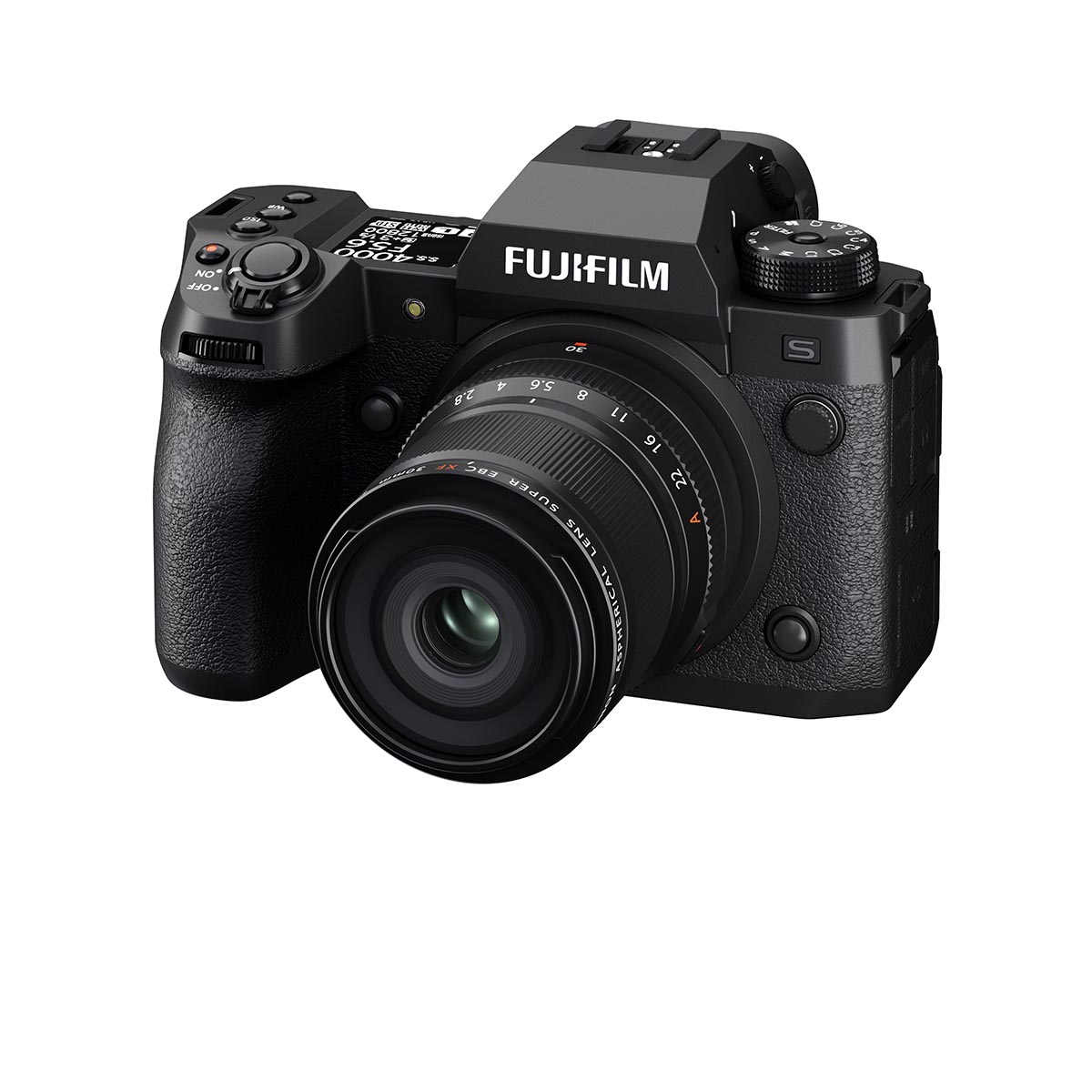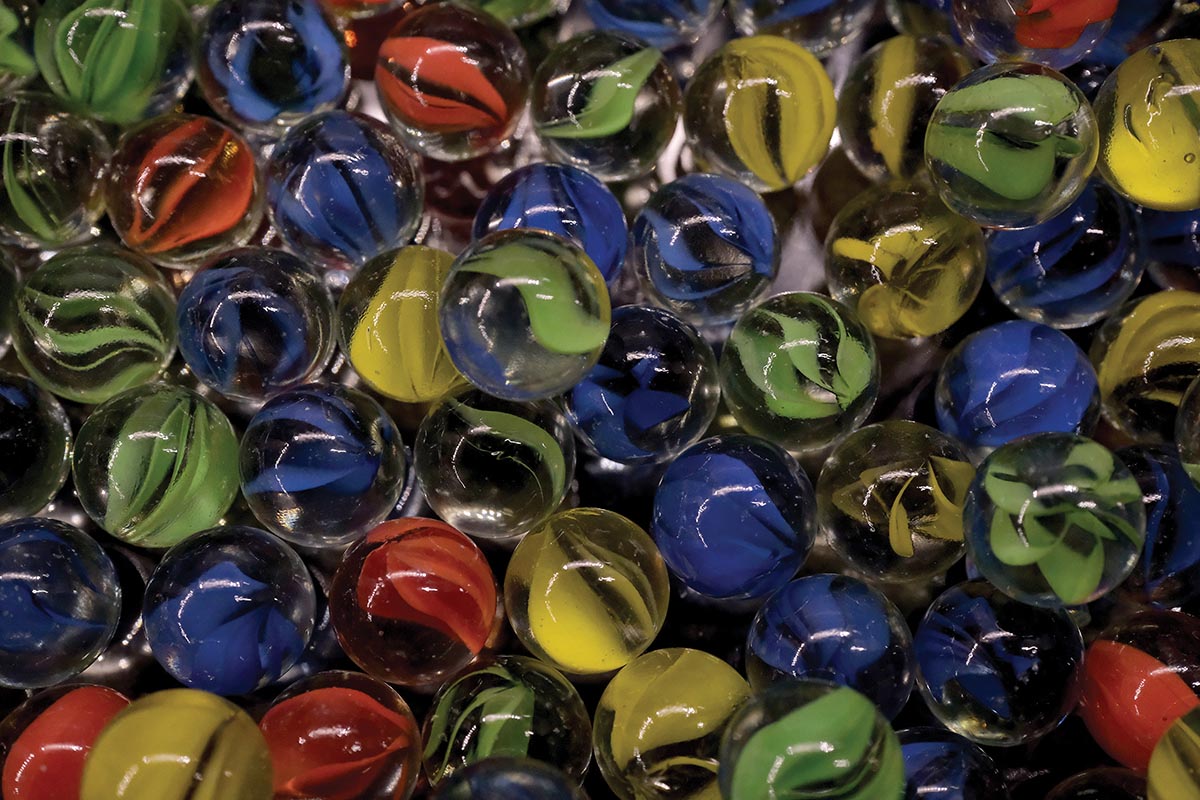
With a higher resolution sensor, new features, and enhanced performance, Fujifilm’s 40-megapixel X-T5 is a worthy upgrade to previous X-T models. This compact camera incorporates the same APS-C sensor and many features from the higher-end Fujifilm X-H2 but maintains the trio of top dials that are the hallmark of the X-T line design.
In addition to higher resolution and better detail capture, the X-T5 delivers faster autofocus, a slightly larger buffer, improved image stabilization, additional subject tracking capabilities (birds, animals), as well as a 160-megapixel multi-shot function. While the Fujifilm X-H2 offers more pro-level video features, the X-T5 can capture 6.2K/30 video.
Also new is an affordable Fujinon XF30mm F2.8 R LM WR Macro lens for $600. I tested the X-T5 with the 30mm f/2.8 lens and appreciated the portability of the combo.

Provia, one of the Fujifilm X-T5’s 19 film simulation modes, produced accurate and natural colors of this glass marble collection.
DESIGN AND USABILITY
Weighing in at 18.9 ounces and measuring approximately 5x3.5x2.5 inches—slightly smaller and lighter than the X-T4—the new model is an excellent travel companion, especially when paired with smaller lenses. Still, it’s sturdy and well-balanced for longer glass. Weather-resistant sealing lets the X-T5 hold up under inclement weather as well as dusty or sandy conditions.
Many of us who cut our photographic teethon 35mm cameras are attracted to the X-T5 because of its top dial configuration for shutter speed, ISO, and exposure compensation. Add a lens with a manual aperture ring and you have the full traditional experience. Customizable front and rear command dials can also be used for exposure settings. In addition to its manual film camera look and feel, I enjoyed being able to use the trio of dials and the aperture ring easily while wearing knit or leather gloves during winter weather. Back-of-camera controls, including playback, AF On, AEL, Quick menu, and other buttons, were also easy to use while wearing gloves. On the other hand, the focus jog button—while responsive— is small and a bit clunky when adjusting the focus point position.
The shutter speed and ISO dials offer lock buttons to avoid accidentally changing those settings. However, the drive dial, located under the ISO dial, doesn’t lock, and I accidentally moved it to bracketing, which was obvious when I pressed the shutter and recorded three shots.
Unlike the X-T4, the new model uses a tilting LCD rather than a fully articulated monitor. While I prefer a fully articulated screen that I can fold against the camera body to avoid scratches, the tilt LCD works well. The camera is equipped with two SD card slots, an HDMI micro connector, and a stereo mini connector for a microphone. There’s no headphone jack, but the X-T5 comes with a headphone adapter. A nicely padded shoulder strap is also included.

With shallow depth of field and an ISO of 6400, the Fuji X-T5 produced a pleasingly soft image of this rose.
IMAGE QUALITY
Since the X-T5 is built around the same sensor as the X-H2, it’s no surprise that image quality is excellent. Colors are rendered faithfully but can be pumped up or toned down with the camera’s film simulation options, and you can apply tints to black-and-white images. The standard color setting, which I shot with most often, simulates Provia film and delivers a natural but not dull look.
At 40-megapixels, it’s not surprising that the X-T5 doesn’t match the low-noise performance of cameras with lower resolution sensors. In a pinch, ISO can be pushed to ISO 12,800. However, with the X-T5’s 7.0 stop in-body image stabilization, ISO 12,800 is an unlikely necessity under all but the most extreme low light conditions.
Of course, the choice of lens impacts sharpness, the presence of chromatic aberration, and other factors. But for a $600 lens, the Fujinon XF30mmF2.8 did quite a good job under most circumstances for both stills and video.

Spot-on exposures were the norm, even on reflective surfaces like this lake.

This slightly off-kilter barn is one of my standard test shots because if the structure’s textured slats. The X-T5 easily reproduced the nuances of the wood exterior.
PERFORMANCE
Autofocus was generally fast and accurate regardless of the AF mode selected. In addition to a half-button press, the X-T5 offers responsive touchscreen AF. Subject tracking was excellent, and I tried the new animal tracking feature, which managed to follow my dog’s eyes, even as he tried his best to avoid looking at the camera. Add his all-black coat, and I was impressed with the tracking’s continuous accuracy.
Continuous shooting speed maxes out at about 15 frames per second, which is the same as the X-H2. But if you’re capturing uncompressed raw files, the X-T5’s buffer stops after about 20 frames. Switch to the electronic shutter for 20fps continuous shooting but with a slightly cropped frame. Here, too, the buffer caps out at around 21 frames. For the most efficient continuous shooting it’s best to go with JPEG or HEIF with 119 frame buffer capacity.
The X-T5’s IBIS has been increased to seven stops and works well when a slow shutter speed is needed. Mechanical and electronic shutters are available with the latter offering a shutter speed of 1/180,000. While that sounds good on paper, without a huge amount of light and an extremely fast-moving subject like a Maglev train (neither of which I had during testing), I’m not sure about its usefulness for most situations. Additionally, on a relatively sunny winter day, with the lens wide open at f/2.8, I still had to push the ISO to about 4000 to get a decent exposure at that shutter speed. But, hey, it doesn’t hurt to have the 1/180,000 option … just in case.
And speaking of the electronic shutter, beware of its rolling shutter. Not awful but obvious.

This normally camera-averse dog couldn’t escape the X-T5’s excellent animal tracking feature.
BOTTOM LINE
The 40-megapixel Fujifilm X-T5 is an excellent APS-C mirrorless camera and relatively affordable at $1,700. Its design is well thought out and, despite a couple of small issues, it handles quite well—even when wearing gloves. Excellent image quality, solid performance, and a compact body add to this camera’s appeal.
Current X-T4 users may want to conduct a detailed comparison with the X-T5 before moving up. And serious videographers who want a full complement of video features should consider the X-H2 and its more sophisticated video features for about $300 more.
The X-T5 is a solid camera for those looking to upgrade or switch to mirrorless. It’s packed with features, especially for still shooting, and delivers solid performance. And, yes, those three dials are not only cool looking but highly functional—especially for photographers who want a 35mm experience from a digital camera.
Theano Nikitas is a photographer and freelance writer covering the photo industry.

